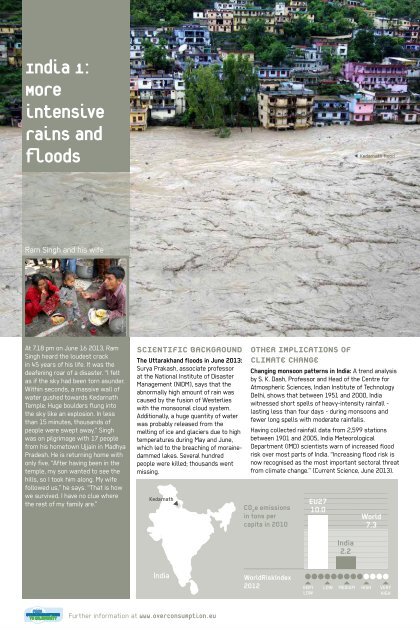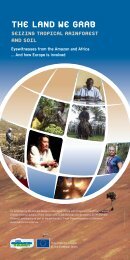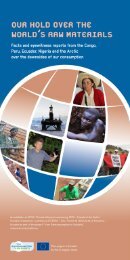WE ARE ALL WITNESSES - PEOPLE IN A CHANGING CLIMATE
The 24 panels of the "We are all witnesses - People in a Changing Climate" exhibition illustrate how climate change is already taking place in 16 countries in four countries.
The 24 panels of the "We are all witnesses - People in a Changing Climate" exhibition illustrate how climate change is already taking place in 16 countries in four countries.
You also want an ePaper? Increase the reach of your titles
YUMPU automatically turns print PDFs into web optimized ePapers that Google loves.
India1:<br />
More<br />
intensive<br />
rainsand<br />
floods<br />
Kedarnath flood<br />
Ram Singh and his wife<br />
© Soma Basu/ Down to Earth<br />
© Rohit Dimri<br />
At 7.18 pm on June 16 2013, Ram<br />
Singh heard the loudest crack<br />
in 45 years of his life. It was the<br />
deafening roar of a disaster. “I felt<br />
as if the sky had been torn asunder.<br />
Within seconds, a massive wall of<br />
water gushed towards Kedarnath<br />
Temple. Huge boulders flung into<br />
the sky like an explosion. In less<br />
than 15 minutes, thousands of<br />
people were swept away.” Singh<br />
was on pilgrimage with 17 people<br />
from his hometown Ujjain in Madhya<br />
Pradesh. He is returning home with<br />
only five. “After having been in the<br />
temple, my son wanted to see the<br />
hills, so I took him along. My wife<br />
followed us,” he says. “That is how<br />
we survived. I have no clue where<br />
the rest of my family are.”<br />
SCIENTIFIC BACKGROUND<br />
The Uttarakhand floods in June 2013:<br />
Surya Prakash, associate professor<br />
at the National Institute of Disaster<br />
Management (NIDM), says that the<br />
abnormally high amount of rain was<br />
caused by the fusion of Westerlies<br />
with the monsoonal cloud system.<br />
Additionally, a huge quantity of water<br />
was probably released from the<br />
melting of ice and glaciers due to high<br />
temperatures during May and June,<br />
which led to the breaching of morainedammed<br />
lakes. Several hundred<br />
people were killed; thousands went<br />
missing.<br />
Kedarnath<br />
India<br />
OTHER IMPLICATIONS OF<br />
<strong>CLIMATE</strong> CHANGE<br />
Changing monsoon patterns in India: A trend analysis<br />
by S. K. Dash, Professor and Head of the Centre for<br />
Atmospheric Sciences, Indian Institute of Technology<br />
Delhi, shows that between 1951 and 2000, India<br />
witnessed short spells of heavy-intensity rainfall -<br />
lasting less than four days - during monsoons and<br />
fewer long spells with moderate rainfalls.<br />
Having collected rainfall data from 2,599 stations<br />
between 1901 and 2005, India Meteorological<br />
Department (IMD) scientists warn of increased flood<br />
risk over most parts of India. “Increasing flood risk is<br />
now recognised as the most important sectoral threat<br />
from climate change.” (Current Science, June 2013).<br />
CO 2<br />
e emissions<br />
in tons per<br />
capita in 2010<br />
15<br />
14<br />
13<br />
12<br />
11<br />
10<br />
9<br />
8<br />
7<br />
6<br />
5<br />
4<br />
3<br />
2<br />
1<br />
0<br />
WorldRiskIndex<br />
2012 VERY<br />
LOW<br />
EU27<br />
10.0<br />
India<br />
2.2<br />
World<br />
7.3<br />
LOW MEDIUM HIGH VERY<br />
HIGH<br />
Further information at www.overconsumption.eu









